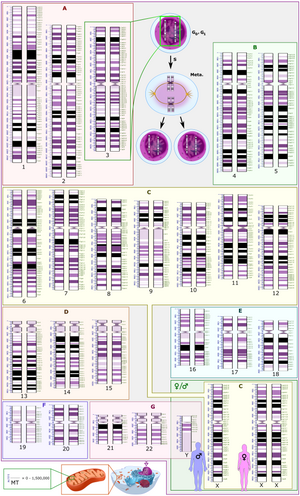International System for Human Cytogenomic Nomenclature
(Redirected from International System for Human Cytogenetic Nomenclature)
The International System for Human Cytogenomic Nomenclature (previously International System for Human Cytogenetic Nomenclature), ISCN in short, is an international standard for human chromosome nomenclature, which includes band names, symbols and abbreviated terms used in the description of human chromosome and chromosome abnormalities.
The ISCN has been used as the central reference among cytogeneticists since 1960.[1][2]


Abbreviations of this system include a minus sign (-) for chromosome deletions, and del for deletions of parts of a chromosome.[4]
Revision history
- ISCN (2020). S. Karger Publishing. ISBN 978-3318068672
- ISCN (2016). S. Karger Publishing. ISBN 978-3318058574
- ISCN (2013). S. Karger Publishing. ISBN 978-3318022537
- ISCN (2009). S. Karger Publishing. ISBN 978-3805589857
- ISCN (2005). S. Karger Publishing. ISBN 978-3805580199
- ISCN (1995). S. Karger Publishing. ISBN 978-3805562263
- ISCN (1991). S. Karger Publishing. ISBN 978-3805555678
- ISCN (1985). S. Karger Publishing. ISBN 978-3805538701
- ISCN (1981). S. Karger Publishing. ISBN 978-3805534840
- ISCN (1978). S. Karger Publishing. ISBN 978-3805530118
- Paris Conference (1971): "Standardization in Human Cytogenetics." (PDF) Birth Defects: Original Article Series, Vol 8, No 7 (The National Foundation, New York 1972)
- Chicago Conference (1966): "Standardization in Human Cytogenetics." Birth Defects: Original Article Series, Vol 2, No 2 (The National Foundation, New York 1966).
- London Conference (1963): "London Conference on the Normal Human Karyotype." Cytogenetics 2:264–268 (1963)
- Denver Conference (1960): "A proposed standard system of nomenclature of human mitotic chromosomes." The Lancet 275.7133 (1960): 1063-1065.
See also
References
- ^ Slovak M.L., Theisen A., Shaffer L.G. (2013) "Human Chromosome Nomenclature: An Overview and Definition of Terms." In: Gersen S., Keagle M. (eds) The Principles of Clinical Cytogenetics. Springer, New York, NY doi:10.1007/978-1-4419-1688-4_3
- ^ Brothman AR, Persons DL, Shaffer LG (2009). "Nomenclature evolution: Changes in the ISCN from the 2005 to the 2009 edition". Cytogenet Genome Res. 127 (1): 1–4. doi:10.1159/000279442. PMID 20110655.
- ^ Warrender JD, Moorman AV, Lord P (2019). "A fully computational and reasonable representation for karyotypes". Bioinformatics. 35 (24): 5264–5270. doi:10.1093/bioinformatics/btz440. PMC 6954653. PMID 31228194.
{{cite journal}}: CS1 maint: multiple names: authors list (link)
- "This is an Open Access article distributed under the terms of the Creative Commons Attribution License (http://creativecommons.org/licenses/by/4.0/)" - ^ "ISCN Symbols and Abbreviated Terms". Coriell Institute for Medical Research. Retrieved 2022-10-27.
External links
- About the ISCN recommendations - Human Genome Variation Society
